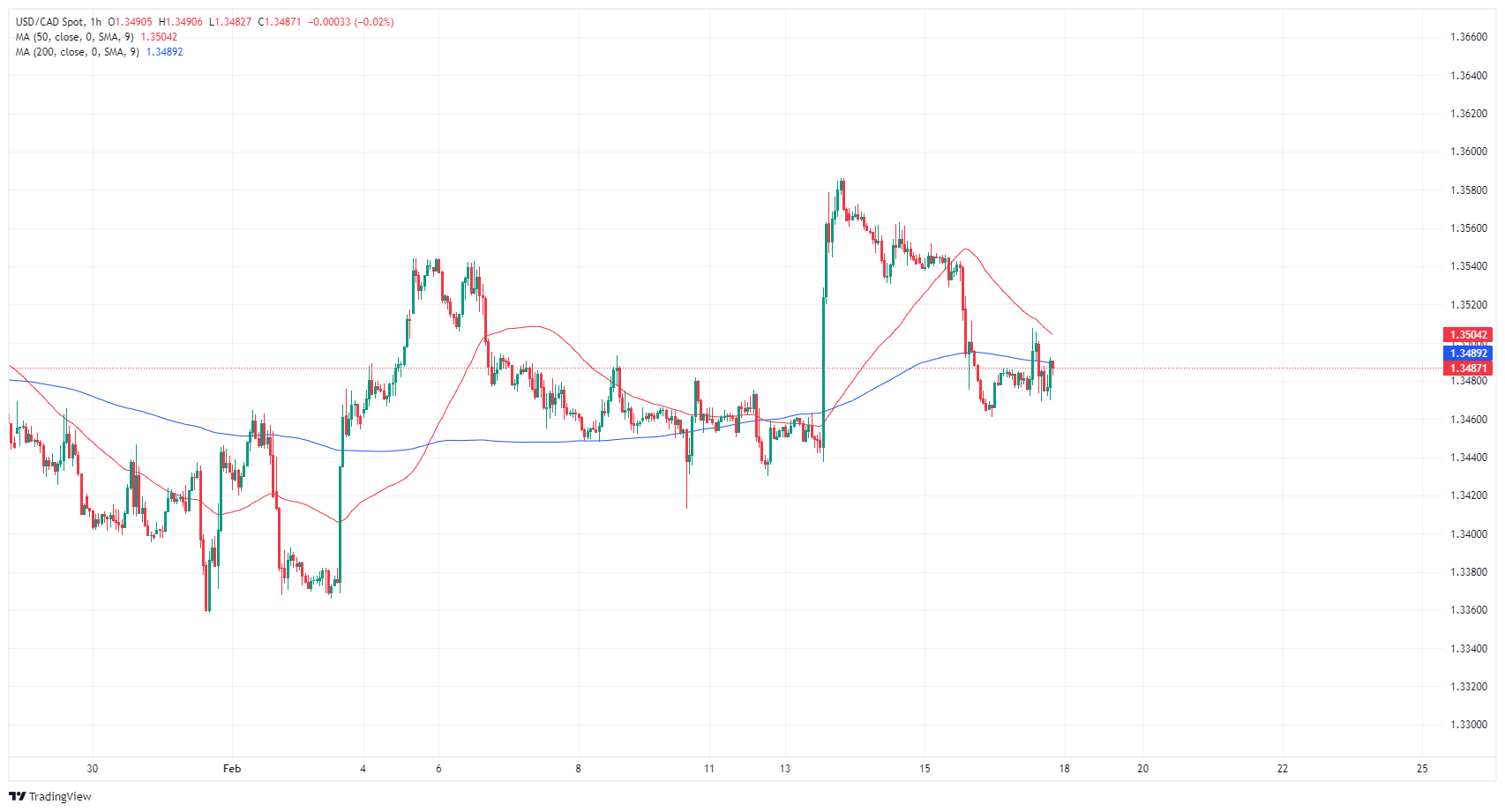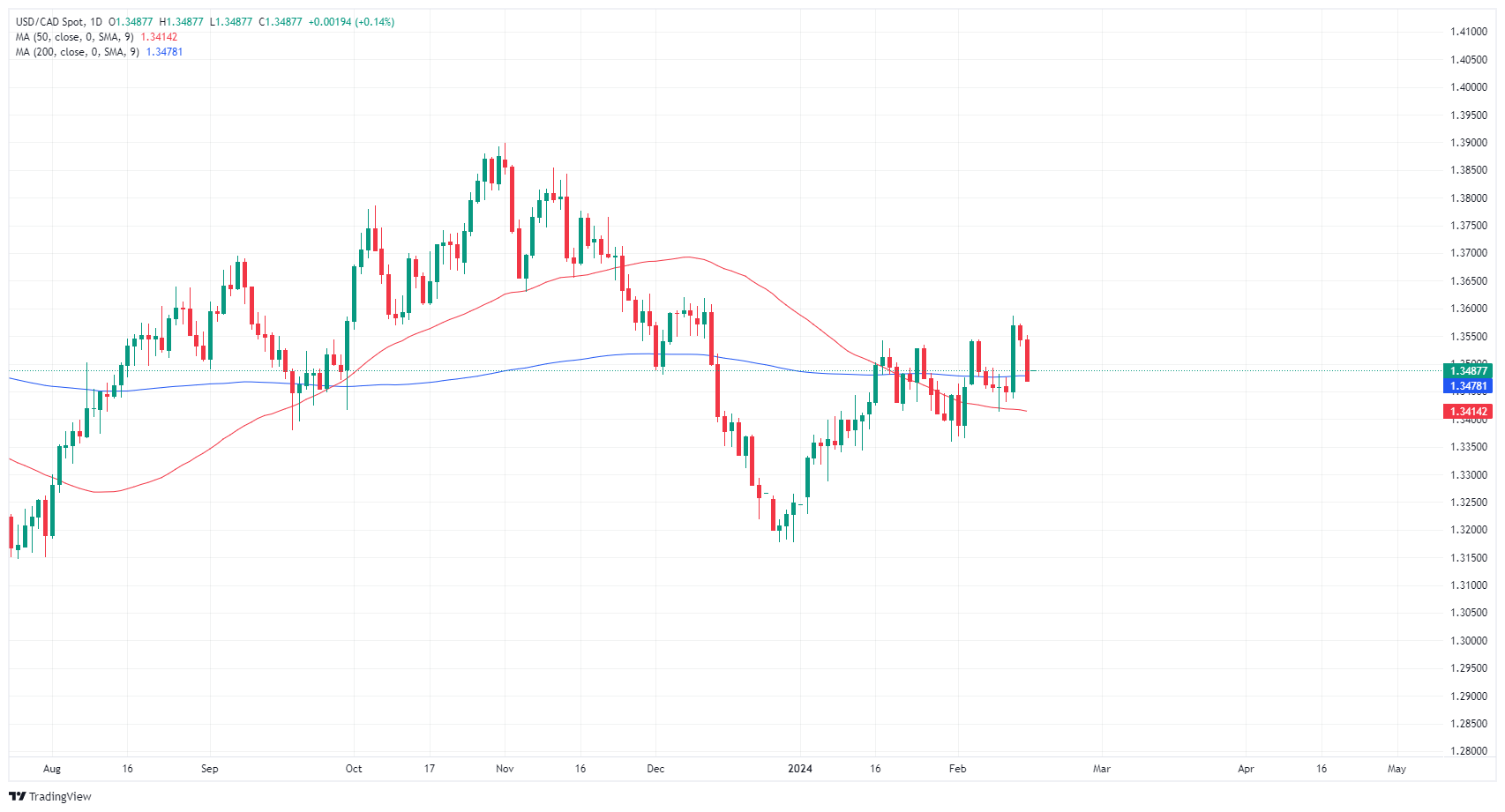Most recent article: Canadian Dollar cycles familiar levels on thin Monday volumes, Canada CPI in the barrel
- Canadian Dollar on weaker footing approaching the closing bell.
- Canada foreign investment barely moved the needle.
- US PPI numbers came in above expectations, hampering rate cut bets.
The Canadian Dollar (CAD) broadly stuck to the middle ground on Friday, finding little room in either direction against the majority of its major currency peers heading into the week’s closing bell.
Canada saw a beat in December’s Foreign Portfolio Investment in Canadian Securities, but overall markets saw attention drawn away for the US Producer Price Index (PPI), which printed above expectations. CAD traders will be looking forward to Canadian Consumer Price Index (CPI) inflation figures due next Tuesday, and rate-cut seekers will be keeping an eye out for the Federal Reserve’s (Fed) latest Meeting Minutes will be dropping on markets next Wednesday.
Daily digest market movers: Quiet Friday sees the Canadian Dollar strung along the middle
- Foreign Portfolio Investment in Canadian Securities grew by $10.44 billion in December, well over the $-6.45 billion forecast. The previous month’s figure saw a minor revision to $11.31 billion from $11.43 billion.
- US Core annualized PPI grew by 2% in January, over the 1.6% forecast and above the previous period’s 1.7% (revised from 1.8%).
- The Michigan Consumer Sentiment Index rose for February, but less than expected, printing at 79.6 versus the forecast 80.0, up from January’s 79.0.
- The University of Michigan 5-year Consumer Inflation Expectations held steady at 2.9%.
- According to the CME’s FedWatch Tool, money markets see a 70% chance of no rate movement from the Fed in May, and June is now on the block as the first rate trim meeting.
- Next week’s Canadian CPI is forecast to tick down to 3.3% from 3.4% for the year ended January.
- MoM Canadian CPI in January is expected to rebound to 0.4% from December’s -0.3%.
- The Fed’s latest Meeting Minutes will be dropping next Wednesday, and investors will be diving into the Federal Open Market Committee’s latest discussions for hints about how close the Fed might be to pivoting into rate cuts.
Canadian Dollar price today
The table below shows the percentage change of Canadian Dollar (CAD) against listed major currencies today. Canadian Dollar was the strongest against the Japanese Yen.
| USD | EUR | GBP | CAD | AUD | JPY | NZD | CHF | |
| USD | -0.01% | 0.00% | 0.16% | -0.10% | 0.20% | -0.25% | 0.14% | |
| EUR | 0.00% | -0.01% | 0.16% | -0.09% | 0.20% | -0.24% | 0.15% | |
| GBP | 0.00% | -0.01% | 0.15% | -0.10% | 0.20% | -0.25% | 0.14% | |
| CAD | -0.16% | -0.19% | -0.17% | -0.27% | 0.04% | -0.41% | -0.02% | |
| AUD | 0.10% | 0.11% | 0.12% | 0.27% | 0.31% | -0.14% | 0.26% | |
| JPY | -0.20% | -0.20% | -0.20% | -0.05% | -0.35% | -0.45% | -0.05% | |
| NZD | 0.24% | 0.24% | 0.25% | 0.41% | 0.15% | 0.44% | 0.39% | |
| CHF | -0.15% | -0.14% | -0.14% | 0.02% | -0.24% | 0.06% | -0.39% |
The heat map shows percentage changes of major currencies against each other. The base currency is picked from the left column, while the quote currency is picked from the top row. For example, if you pick the Euro from the left column and move along the horizontal line to the Japanese Yen, the percentage change displayed in the box will represent EUR (base)/JPY (quote).
Technical analysis: Canadian Dollar on the flat side on Friday as markets settle ahead of the Friday close
The Canadian Dollar (CAD) saw some weakness on Friday, backsliding against most of its major currency counterparts. The CAD is down about 0.15% against the US Dollar, and fell around a quarter of a percent against the Australian Dollar (AUD). The Canadian Dollar is close to flat against the Japanese Yen (JPY), and down four-tenths of a percent against the recovering New Zealand Dollar (NZD).
The USD/CAD continues to cycle the 200-hour Simple Moving Average (SMA) near 1.3490 as the pair gets hampered near the 1.3500 handle.
Rough chop on daily candlesticks leaves USD/CAD hamstrung on the 200-day SMA, and near-term swing lows continue to test back into recent consolidation. Despite halting progress, the pair is still up around 2.3% from December’s lows near 1.3175.
USD/CAD hourly chart
USD/CAD daily chart
Canadian Dollar FAQs
What key factors drive the Canadian Dollar?
The key factors driving the Canadian Dollar (CAD) are the level of interest rates set by the Bank of Canada (BoC), the price of Oil, Canada’s largest export, the health of its economy, inflation and the Trade Balance, which is the difference between the value of Canada’s exports versus its imports. Other factors include market sentiment – whether investors are taking on more risky assets (risk-on) or seeking safe-havens (risk-off) – with risk-on being CAD-positive. As its largest trading partner, the health of the US economy is also a key factor influencing the Canadian Dollar.
How do the decisions of the Bank of Canada impact the Canadian Dollar?
The Bank of Canada (BoC) has a significant influence on the Canadian Dollar by setting the level of interest rates that banks can lend to one another. This influences the level of interest rates for everyone. The main goal of the BoC is to maintain inflation at 1-3% by adjusting interest rates up or down. Relatively higher interest rates tend to be positive for the CAD. The Bank of Canada can also use quantitative easing and tightening to influence credit conditions, with the former CAD-negative and the latter CAD-positive.
How does the price of Oil impact the Canadian Dollar?
The price of Oil is a key factor impacting the value of the Canadian Dollar. Petroleum is Canada’s biggest export, so Oil price tends to have an immediate impact on the CAD value. Generally, if Oil price rises CAD also goes up, as aggregate demand for the currency increases. The opposite is the case if the price of Oil falls. Higher Oil prices also tend to result in a greater likelihood of a positive Trade Balance, which is also supportive of the CAD.
How does inflation data impact the value of the Canadian Dollar?
While inflation had always traditionally been thought of as a negative factor for a currency since it lowers the value of money, the opposite has actually been the case in modern times with the relaxation of cross-border capital controls. Higher inflation tends to lead central banks to put up interest rates which attracts more capital inflows from global investors seeking a lucrative place to keep their money. This increases demand for the local currency, which in Canada’s case is the Canadian Dollar.
How does economic data influence the value of the Canadian Dollar?
Macroeconomic data releases gauge the health of the economy and can have an impact on the Canadian Dollar. Indicators such as GDP, Manufacturing and Services PMIs, employment, and consumer sentiment surveys can all influence the direction of the CAD. A strong economy is good for the Canadian Dollar. Not only does it attract more foreign investment but it may encourage the Bank of Canada to put up interest rates, leading to a stronger currency. If economic data is weak, however, the CAD is likely to fall.
Information on these pages contains forward-looking statements that involve risks and uncertainties. Markets and instruments profiled on this page are for informational purposes only and should not in any way come across as a recommendation to buy or sell in these assets. You should do your own thorough research before making any investment decisions. FXStreet does not in any way guarantee that this information is free from mistakes, errors, or material misstatements. It also does not guarantee that this information is of a timely nature. Investing in Open Markets involves a great deal of risk, including the loss of all or a portion of your investment, as well as emotional distress. All risks, losses and costs associated with investing, including total loss of principal, are your responsibility. The views and opinions expressed in this article are those of the authors and do not necessarily reflect the official policy or position of FXStreet nor its advertisers. The author will not be held responsible for information that is found at the end of links posted on this page.
If not otherwise explicitly mentioned in the body of the article, at the time of writing, the author has no position in any stock mentioned in this article and no business relationship with any company mentioned. The author has not received compensation for writing this article, other than from FXStreet.
FXStreet and the author do not provide personalized recommendations. The author makes no representations as to the accuracy, completeness, or suitability of this information. FXStreet and the author will not be liable for any errors, omissions or any losses, injuries or damages arising from this information and its display or use. Errors and omissions excepted.
The author and FXStreet are not registered investment advisors and nothing in this article is intended to be investment advice.
Recommended content
Editors’ Picks

EUR/USD struggles to hold above 1.0400 as mood sours
EUR/USD stays on the back foot and trades near 1.0400 following the earlier recovery attempt. The holiday mood kicked in, keeping action limited across the FX board, while a cautious risk mood helped the US Dollar hold its ground and forced the pair to stretch lower.

GBP/USD set to swoon on holiday-shortened week
GBP/USD waffled near the 1.2550 level on Monday, kicking off the holiday trading week with a third of a percent decline as market sentiment coils. Market volumes are set to drain out of global exchanges as investors broadly hang up their hats for the Christmas holiday, and global markets will be shuttered on Wednesday.

Gold flat lines above $2,600 ahead of holiday trading week
Gold price trades flat around $2,610 during the early Asian session on Tuesday. Markets face a relatively quiet trading session ahead of the holiday trading week. The US Richmond Fed Manufacturing Index for December is due later on Tuesday.

Ethereum risks a decline to $3,000 as investors realize increased profits and losses
Ethereum is up 4% on Monday despite increased selling pressure across long-term and short-term holders in the past two days. If whales fail to maintain their recent buy-the-dip attitude, ETH risks a decline below $3,000.

Bank of England stays on hold, but a dovish front is building
Bank of England rates were maintained at 4.75% today, in line with expectations. However, the 6-3 vote split sent a moderately dovish signal to markets, prompting some dovish repricing and a weaker pound. We remain more dovish than market pricing for 2025.

Best Forex Brokers with Low Spreads
VERIFIED Low spreads are crucial for reducing trading costs. Explore top Forex brokers offering competitive spreads and high leverage. Compare options for EUR/USD, GBP/USD, USD/JPY, and Gold.